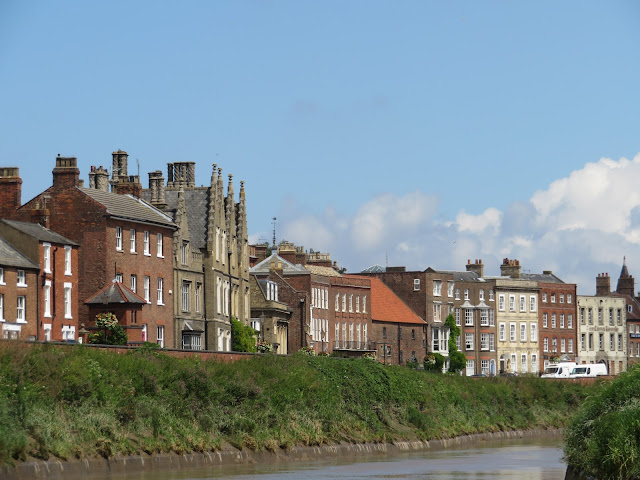From Whittelsey we left and headed for Peterborough.
Whittelsey is well known for it's brick factories and at least three of these chimneys were smoking, and its McCain's chip factory too. We passed out through Stanground Lock and back on to the River Nene. We didn't go out that night but enjoyed the calm on the end of the embankment moorings.
The next day we left for our timed arrival at the Dog in a Doublet Lock and our release down on to the tidal Nene. The lock is named after the pub that was named after a publican's dog who had some sking complaint and so it wore a doublet to keep it warm. We locked down on our own thanks to the lock keeper and he advised us to wait about half an hour so as to get to Wisbech at a good time. It seemed to be just about the start of the fall of the tide when we left.
The water is wide and you get little idea of the speed of the current until you actually get to a bend or a slightly more narrow part.
This is what's left of the Great Northern Railway bridge at Guyhirn. The railway became disused in 1963 and the bridge, or most of it, was removed in 1982. I seem to remember this was the first bend in the river. One or two bridges been to only feature of note otherwise.
As we approached Wisbech the channel narrows and the tide had dropped further so I was wary of the bends by then. The views over the bank were great, making us think of Italian townscapes like Pisa!
We cleared Town and then we were looking for our berth on the Yacht Harbour pontoons. We had our instructions but had to improvise a little in the end. I was prepared to continue to the ships turning area to turn, but the lock keepers advice was solid as turning off the berth was no problem and saved us flogging back against the current.
The day we arrived in Wisbech was Helen's birthday so not only did I get her tidal cruise I also got a brewery tour for her! In fact I knew there wasn't a brewery tour on that day but there are quite extensive gardens behind the brewery, plus a little museum so we walked up the bank in beautiful weather to check out Elgoods Brewery. There is a tea room but luckily for me they also served beer. The brewery was first started in 1786 as a pub brewing its own beer. In 1795 it was North Brink Brewery with 4 tied houses when sold. It was the first classic Georgian Brewery built outside of London. By 1801 it came with 6 pubs and in 1877 when the first Elgood got involved with a partner there were 70 pubs and 21 of them in Wisbech. By 1878 it was an Elgood running the show alone and now they are on the fifth generation, and I believe they still live next door.
You can see that they claim 1795 as the start date. The Family believe in the old tied house system and have about 36 pubs all within 60 miles of the brewery. They have also reached out to the free trade pubs and sell all over the country now.
I like to try a mild when I see them as it isn't that often they are on the bar. This nice reddy black pint, 3.6%, didn't disappoint as although been only low alcohol it was full of flavour. The crystal malts and roasted barley give it a good mouthful and coffee and chocolate bottom notes. The single hop Fuggles and a tang and dryness it the end. Felt nice and rich and something that you could drink several pints of without being filled up, if you see what I mean. The tea room had no cider so Helen tried a Cherry wheat beer beer from that she enjoyed too. The name black god does not come from a fit of depression like Winston Churchill, but the black dog that adorns the Elgood's coat of arms.












































